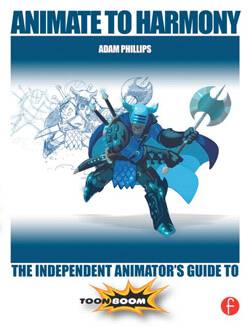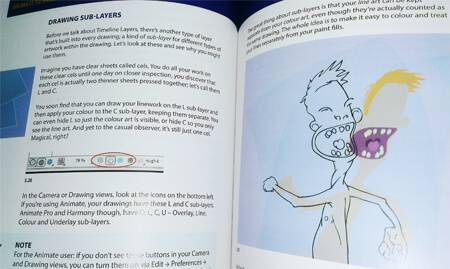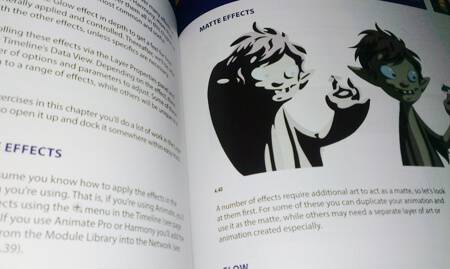Toon Boom ‘Animate To Harmony’ Book Review
 Animate To Harmony: The Independent Animator’s Guide to Toon Boom
Animate To Harmony: The Independent Animator’s Guide to Toon Boom
Author: Adam Phillips
Publisher: Focal Press
A love letter to a piece of software seems a little daft given my dual (dueling, on occasion) roles as both animation freelancer/director and researcher/writer; It’s obvious to many that, leagues ahead of the software itself, it’s the artist and ingenuity of a core idea that makes an animated project a success. A great concept can, with varying degrees of effort and adaptation, be realised just as effectively in a variety of programs, yet we all have our comfort zones – independent studios and professionals who cut their teeth on Adobe’s Creative Suite still swear by Flash, After Effects et al, the British children’s TV scene clearly has a friend in the Cel Action pipeline and aesthetic, CG mograph artists tend to love themselves some Cinema 4D while CG character animators oftentimes cluster together in the AutoDesk camp, and so forth. Largely it depends on that balance of intuitive interface, ease-of-workflow and impressive end results. More often than not this desired output warrants a bit of a software cocktail – get that Flash walk cycle into After Effects, sprinkle it with some magic plugin dust and you got yourself some purty-lookin’ animation, boy – though one program has recently stood out as being exceptionally all-encompassing to us 2D folks.
Having been presented with an already out-of-date, foetal version of Toon Boom Studio at one point during my MA in 2006, I wrote the software off for too long assuming it was a clunky relic, vaguely reminiscent of the Macromedia applications Adobe didn’t have the confidence to eventually usurp. In actuality the program has turned out to be the antithesis of this first impression. Since plunging into Animate Pro it’s been my first port of call for 2D animation when going the traditional lightbox route isn’t an option. The global animation industry seems to presently be in agreement, with most of Disney, Warner Bros and Nickelodeon’s recent 2D animated features and major TV projects being animated primarily using Toon Boom, not to mention independent productions and the glut of TV series headed up by Fox’s entire Animation Domination line-up. For home use it’s understandable that people in my position have been a little behind – the types of hardware and memory considerations to facilitate the software’s potential most harmoniously (Eh? Eh?) have only become the affordable norm in recent years.

Rather than attempt a review of the software itself, for this article I’m taking a look at Adam Phillips‘s Animate To Harmony, a long-overdue tome dedicated to the virtues and ease of use Toon Boom has boasted for some time now. With apparent co-operation from the company itself, the book serves as an extension of the software’s official literature, which already goes to great lengths to make the software as non-intimidating as possible (Toon Boom’s written and visual tutorials are amongst the clearest I’ve ever encountered). Phillips (AKA Chluaid)’s own reputation as a producer of some of the web’s most exceptional and considered original content, not to mention his own series of video tutorials, makes him an ideal scribe for a book which reads with such ease and informality as to be one of the finest and most accessible instructional manuals I’ve thus far encountered (and I’ve ploughed through a mountain of the bloody things). Ultimately it feels like what it is – an animator sitting down with another animator and talking through the ins and outs on their terms.
An initial concern that the title brings up is that the book may be of little use to those who don’t use Toon Boom Harmony, the most studio-friendly and all-encompassing edition of the software; I myself have stuck with Animate Pro for projects and commissions. Fortunately Phillips makes the wise move of generally presenting each area at the basic level accommodated by Animate, with instructional elements specific to Animate Pro and/or Harmony serving as an addition to the core concepts. It’s worth bearing in mind that earlier or supplemental editions of the software such as Studio or Storyboard aren’t specifically covered. For those who work with Animate/Animate Pro 2 or earlier, unavailable features are helpfully made clear. Ultimately the book gives readers a strong idea of the lay of the land as far as Toon Boom’s interface which, once fundamentally understood, is pointedly easy to adapt to between versions.

Though there is much on offer for those who have previously worked through the official tutorials and manual, the brass tacks of the software’s fundamentals are explored to the same extent so the uninitiated won’t require much by way of catching up. Tutorials are peppered throughout and invite readers to experiment as they learn rather than insistence on rote learning. Divided into seven main categories – interface, tools, animation, effects, camera, audio and rendering – there is also much by way of additional hints, tips and valuable information on ways to harness the software’s capabilities; Its ease of use for illustration and comic-based projects, for example. The animation section is, reasonably, the book’s major focus and it doesn’t skimp on covering all the essential ground. Beginning with rudimentary exercises to test the waters, the more elaborate world of sub-layers, forward/inverse kinematics, easing and full animation is presented in easily digestible subsections that don’t attempt to explain everything at once but in a sequence that comes across as organic and instinctual. Most importantly the book demystifies the post-production and visual effects areas that, being ‘beyond animation’, prove to often be as equally effective as many one might find in After Effects, and just as intuitive (more so once fully acclimated to Toon Boom’s layout and shortcuts).
Ultimately this is a book that will not only leave you inspired to work more, but to try new things and have a great time doing so.
Animate To Harmony is out now from Focal Press. To learn more about the work of Adam Phillips visit his website at bitey.com

